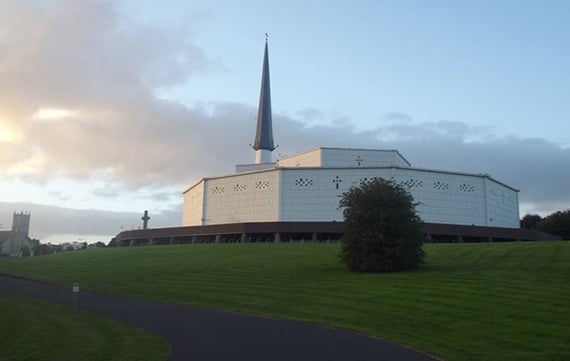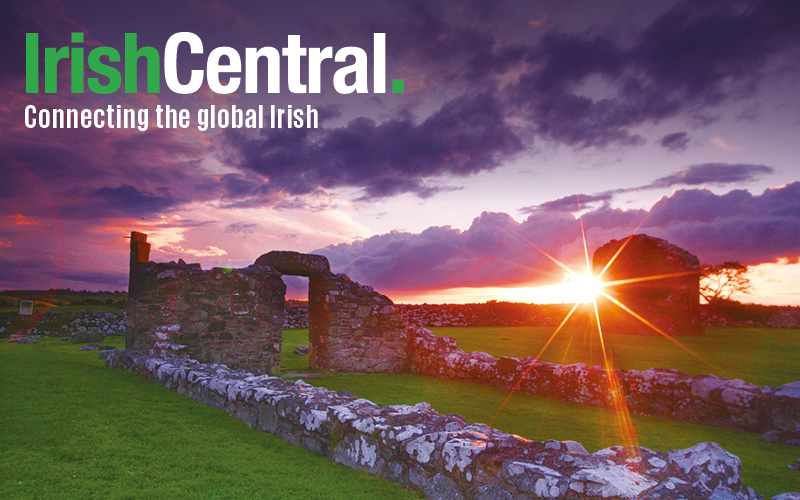The Connacht county of Mayo is now mostly associated with their GAA team's seemingly endless hunt for Sam Maguire, the cup awarded to the winner of the All-Ireland Senior Football Final, which has evaded their grasp for decades despite many close calls and second places.
Named after the plain of the yew trees, the county stands proud, despite its disappointment on the playing field, on the shore of the Atlantic Ocean and, as with any of the counties along the Wild Atlantic Way, offers some incredible views over the water, as well as a memory of the past at every turn.
Read more: Mayo and the Cliffs of Moher tours
Home to Ireland’s largest island – Achill Island – and the country’s highest cliffs – Croaghaun, Achill Island – it’s hard to pick just five tourist attractions in Mayo, but these are our favorites:
Croagh Patrick
A tough trek to the summit of Croagh Patrick. 
One of Ireland and Mayo’s most famous landmarks, Croagh Patrick (sometimes referred to as the holiest mountain in Ireland) is located just outside of the beautiful and vibrant town of Westport and is known as the place where St. Patrick spent 40 days and 40 nights praying and fasting during his years as a missionary in Ireland.
The mountain has been a place of pilgrimage for 5,000 years. Originally pilgrimage to Croagh Patrick was part of a pagan ritual during which people are thought to have gathered there during the harvest season. The tradition has continued interrupted to today through Ireland's transition from a pagan to a Christian country.
Pilgrims climb the 2,500 ft mountain to the church at its peak every day of the year, but thousands of visitors can be expected on the last Sunday of July, or “The Reek” as it’s locally known. They beginn their pilgrimage to the top with mass at St. Patrick’s statue at the mountain’s base.
Croagh Patrick is not just for Christians, however, but for anybody who finds their religion, or lack thereof, in the beauty of nature. A tough undertaking, take your time climbing to the summit and make plenty of stops to rest and gaze out over the Mayo countryside and the magnificent views over Clew Bay.
A statue in honor of St. Patrick at Croagh Patrick in Co. Mayo.
Located at the base of the pilgrim's path up the mountain is the Croagh Patrick Visitors Center, Teach na Miasa, run by the Walsh family. The center is built on a roadway named “Bóthar na Miasa”, or “Road of the Dishes,” so called as it is said that the monks of nearby Murrisk Abbey washed their utensils in the stream which runs alongside.
Opposite the center is the National Famine Monument. The population of Co. Mayo was among the worst hit during the Great Hunger. The dramatic sculpture depicts a "Coffin Ship" with skeletal bodies in the rigging and was unveiled by President Mary Robinson in 1997.
More information: http://www.croagh-patrick.com/
Read more: Galway and the West tours
Westport and Westport House
The colorful and energetic Westport town. 
After the almost four-hour average round-trip up and down Croagh Patrick, visitors are sure to have worked up an appetite large enough to enjoy the many bars and restaurants lining the streets of the nearby town of Westport.
This charming little town has stolen the heart of many a traveler with its brightly colored shop fronts and energetic feel.
Once you’ve recovered from the “Reek,” make your way out to Westport House and its Pirate Adventure Park, a tribute to its former resident, Irish pirate queen Grace O’Malley (otherwise known as Gráinne Mhaol).
The house itself is built on the remains of O’Malley’s Castle dating to the 16th century when O'Malley ruled as Pirate Queen of Connacht and controlled all the land and seas surrounding Westport. The current structure, however, was first built in 1650 by Colonel John Browne and his wife Maud Burke, Grace O’Malley’s great-great-granddaughter, and has since developed from a one-room residence to the large stately house that it is today. There are currently 30 rooms on display throughout the house, as well as six exhibitions, while the remains of O’Malley’s castle can be seen from the dungeons.
Zorbing fun at Westport House. 
Every room of the house is breathtaking in its grandeur right from the time you enter the front hall and witness the marble staircase where you can greet the mythological Angel of Welcome centerpiece. The family tradition was to shake the angel’s hand upon returning from trips or visiting.
On the grounds of the house is a more modern tribute to the sense of adventure of the Pirate Queen with the Pirate Adventure Park. With jumping castles, go-karting, real-life dungeons, pedalo boats, and rides including the Cannonball Run slide, Pirate Queen Swinging Ship and Pirates Plunge (Ireland’s only log flume ride), Westport House becomes a top pick for family days out.
More information: http://www.westporthouse.ie/
Read more: Top five female Irish heroes from history (PHOTOS)
The Great Western Greenway
Leave the car behind and take a stroll or a cycle along this 42-km trailway. 
If you’re going to be traveling from place to place in Ireland, there’s no better way to do it than by renting a car or getting yourself onto a tour bus because no public transport will bring you outside of the main towns and villages. If you’re sick of observing the country through your car window, however, the Great Western Greenway is the ideal option for you, allowing you to step out and stretch your legs on the longest off-road walking or cycling experience in the country.
The 26 mile (42km) greenway stretching from Achill Island to Westport will shake off the cobwebs. You can take on the full trail or take it in one of the three sections: between Achill and Mulranny, Mulranny and Newport, or between Newport and Westport.
A couple of cyclists enjoy the Great Western Greenway. 
Named as a European location of excellence, this traffic-free trail follows the route of the renowned Westport to Achill railway, which closed just 42 years after it was built. It was hoped that the rail line would bring prosperity to west Mayo by attracting travelers eager to explore the towns and sandy beaches, but it never met those expectations, mainly because of the further development of roads out west through the 1930s. The last train ran on the line in the Fall of 1937 and it lay unused until developed into the Greenway.
The Greenway will take you past many of Mayo’s top attraction including Croagh Patrick, the Céide Fields, a deserted famine village in Achill, the National Museum of Country Life, and the Ballycroy National Park. Further, there are some top-class hotels along the trail, making it possible to take a few days to explore the whole trail by foot or on rented bicycles, which can be found in any of the four main towns listed along the way.
More information: http://www.greenway.ie/index.html
Read more: Dublin and surrounding areas tours
Knock Shrine
The Knock Shrine is internationally renowned as a place of prayer and pilgrimage. In the 19th century fifteen locals claimed that the image of Our Lady, St. Joseph, St. John the Evangelist, an altar, cross and a lamb appeared to them in the small village.
On August 21, 1879, Mary McLoughlin, housekeeper to the parish priest of Knock,and her friend Mary Byrne were astonished to see the outside south wall of the church bathed in a mysterious light, with three figures standing in front of the wall. The figures were said to float a few feet above the crowd and Byrne quickly gathered the other 13 witnesses who were to attest to the miracle.
Although the claim was quickly condemned as a cruel joke by local Protestant policemen, pilgrimages to Knock began as early as 1880 and visitors began to report miracles and healings taking place during their stay there.
Since then, and following several apparent cures and the visits of Pope John Paul II and Mother Teresa, Knock has been transformed into a compound of prayer spanning one hundred acres and containing five churches.

The Knock Shrine Basilica.
The tradition continues today despite Ireland's increasingly secularism.
Visitors can take advantage of guided tours that will bring you through the beautifully landscaped grounds, as well as places of interest such as the Apparition Chapel and original Gable Wall, Papal Cross, Basilica, and Chapel of Reconciliation, passing on a greater understanding of the apparition.
The Shrine also contains a museum that captures the unique story of Knock by setting the scene of life in Ireland in the 1870s and retelling the stories of the witnesses through their own handwritten letters.
More information: https://www.knockshrine.ie/
The Céide Fields
There are few places in Ireland where the feeling of being surrounded by the truly ancient is more profound than at the Céide Fields in Belderrig, Co. Mayo, home of the oldest known field system in the world.
Located along dramatic 360-foot high cliffs and looking straight out onto the Atlantic Ocean, the Céide Fields (or Achaidh Chéide meaning “flat-topped hill fields”) is a remarkable neolithic site first discovered in the 1930s.
It was while he was cutting turf that the local schoolmaster Patrick Caulfield first started coming across large numbers of stones deep down in the bog. In later years, Caulfield's archaeologist son Seamus returned to the site of the stones to investigate further. He discovered cultivated fields, houses, and tombs using iron probes normally employed for finding ancient trees under areas of deep bog.
Read more: Kerry and the Wild Atlantic Way tours
The Céide Fields in their most dramatic of settings. 
The farmland is believed to date from around almost 6,000 years ago, the oldest of its kind in the world, and has greatly helped research of the Neolithic period circa 3,500 BC.
Since its discovery, an award-winning interpretive visitor center has been built near the site, featuring a 4,000-year-old ancient tree unearthed from the nearby bogland in the entrance hall. The building itself has been heralded as a fantastic piece of architecture totally in keeping with its rural environs.
The Céide Fields Visitor Center. 
More information: http://www.museumsofmayo.com/ceide.htm
Read more: Ireland’s travel secrets: The Céide Fields (PHOTOS)




Comments